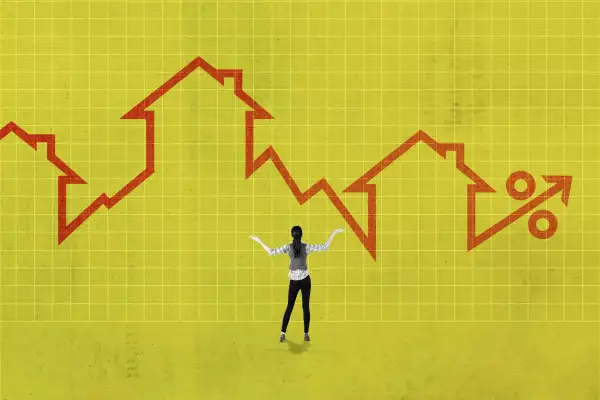How to Buy a Home When Mortgage Rates Are So Volatile

Homebuyers have faced a litany of challenges lately.
For two years, housing prices climbed, while inventory remained at a standstill. Now the market is finally starting to cool off, making the hunt for an affordable home less of a pipe dream for priced-out buyers. But fickle mortgage rates are creating yet another hurdle.
Interest rates have bobbed up and down since June; swinging between 5.89% to 4.99%, within a matter of weeks. And that's making it hard for buyers to figure out whether or not they can actually afford a home.
“Month-to-month, we’re jumping around half a percent,” says Skylar Olsen, chief economist at Zillow. “That [has] a really big impact on mortgage payments.”
Experts recommended paying no more than 33% of your monthly income on housing costs like mortgage payments, taxes and insurance. For many people perusing the housing market right now, the week-to-week movement of current mortgage rates can push them over that threshold.
Here's a recent example. Between May 31 and June 30, Freddie Mac's benchmark mortgage rate increased from 5.09% to 5.70%. At the same time, according to Olsen, the percentage of monthly income spent on housing costs for a household earning $74,000 (close to the estimated national median income of $71,300) increased from 32.36% to 34.21%. When rates went back down to 5.17% at the end of July, the percentage dropped back down to 32.49% — back under that expert-recommended max of 33%.
As a result, many homebuyers have decided to sit on the sidelines for the foreseeable future. New homebuyers—and those who are still actively looking— should prepare for a bumpy ride. Olsen expects rate volatility to continue to bounce between 5% and 6% for the rest of the year.
How to buy a home when mortgage rates are volatile
The home buying process can be complicated — especially if you’re new to the market and haven’t experienced the stress of ever-changing interest rates.
“It’s a lot of sticker shock, and a lot of people who are trying to adjust,” says Shmuel Shayowitz, president and chief funding officer at the mortgage lender Approved Funding.
To make the process easier, and to avoid getting blindsided by a rate hike, find a good lender, and ask for help identifying options you may not be aware of.
“Don’t be afraid to leverage their knowledge and their contacts and their resources,” advises Shayowitz.
Consider different rate scenarios
It helps if you go into the mortgage application process with some idea of how different interest rates will affect your monthly payments, as well as your ability to afford those payments.
You can use a mortgage calculator to get a payment estimate at different rates. Start off with the advertised rates of the lender you’re considering, then see how a change — both higher and lower — of an ⅛, a ¼ and ½ of a percent makes.
Remember that a calculator, while useful, can only give you an estimate. The actual rate you qualify for will depend on the lender, your credit score and other financial information. As a backup, ask your lender to also run the numbers — and to lay out different rates and payment scenarios.
Keep an eye on interest rate movement
Getting a mortgage pre-approval letter is always a good practice, since it lets sellers know that you already have the proper financing in place.
But Shayowitz cautions against blindly trusting that the rates and terms that applied when you were pre-approved are still valid, as these can ebb and flow with the market.
Make it a point to check in with your lender regularly to avoid any unpleasant surprises. Better yet, Shayowitz says, ask them to send you rate updates via text, call or email.
Keep track of the expiration date on that pre-approval letter as well: most will only be valid for 30 to 60 days.
Get prequalified for a higher rate
If you're not quite ready for a mortgage pre-approval, ask your lender for a pre-qualification, which is based on the financial information you provide (like your income and the amount of debt you have) and doesn't require a full credit check.
Mortgage prequalifications hinge on current interest rates, which can hurt your loan application if rates increase while you're shopping for a home. To combat this, ask your lender if you can get prequalified, or even preapproved, for a higher rate. Rates can change on a daily basis, and while a lower rate won’t affect the status of your application, a higher rate could tank it. Plus, it won’t hurt to know how high a rate you can reasonably expect to qualify for.
Consider different loan options
Most U.S. homebuyers opt for a 30-year fixed-rate mortgage, but that’s not the only option. You can also consider an adjustable-rate mortgage, which will have a lower introductory interest rate — sometimes up to 1% lower.
ARMs have a fixed introductory rate that won’t change over a period of five, seven or ten years, depending on the term you choose. You'll have the option of refinancing the mortgage if rates go down before that introductory period ends. (Many experts believe interest rates will fall below 5% once the economy stabilizes and inflation is under control.)
If you are considering an ARM, be sure to have your lender explain when the interest rate would begin to adjust, and how high it could potentially rise. Once your intro period ends, rates — and the amount of interest you're on the hook for — could climb into double digits.
Lock in your rate
Once you’ve found your dream home and are waiting to close on it (a process that takes about 30 to 50 days), be sure to get a rate lock from your lender. This guarantees your mortgage rate won't increase every time the average rate does — which, again, can happen on a daily basis. It can also help you lock in a good deal at a low rate.
You can typically lock in your rate for anywhere between 30 and 60 days, although some lenders offer rate locks for up to 90 days. Ask your lender if they have a “float down” option, which would keep your rate from increasing while allowing you to snag a lower one if mortgage rates fall before closing.
Best Mortgage Lenders of September 2022
Why a Recession Could Help Homebuyers — Plus 5 Tips for Buying During a Downturn

